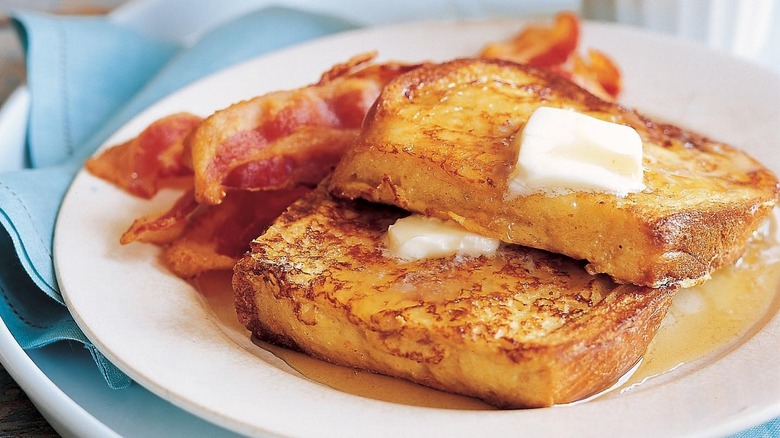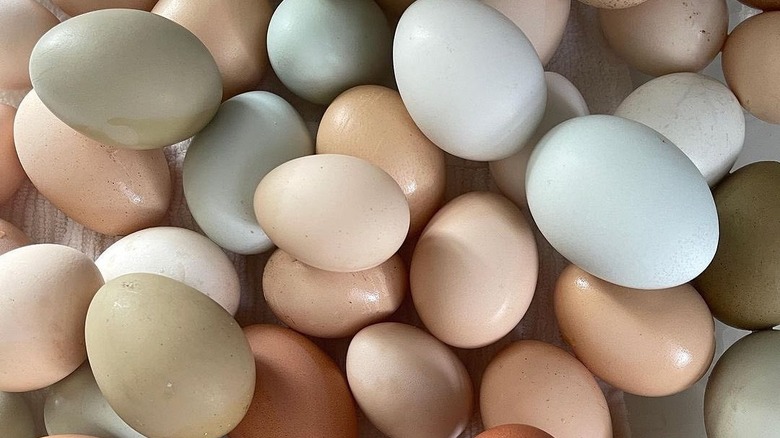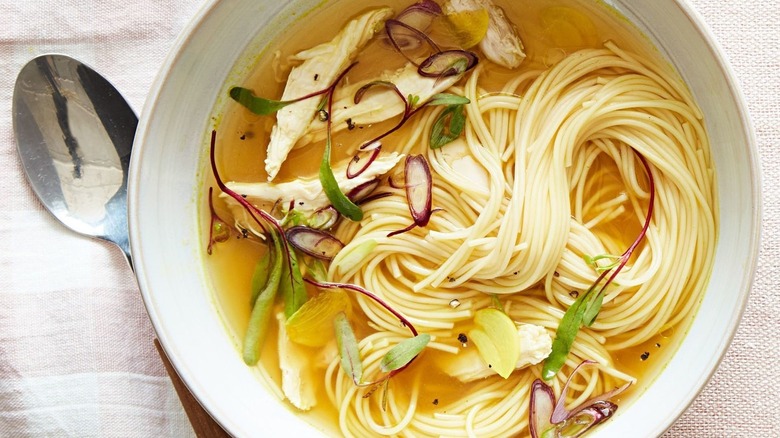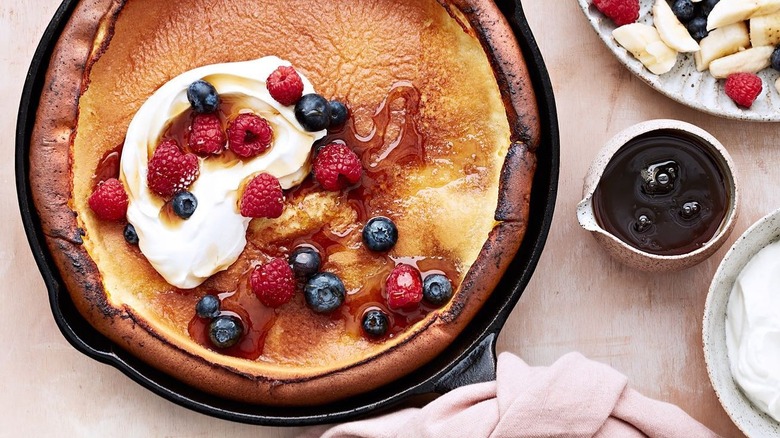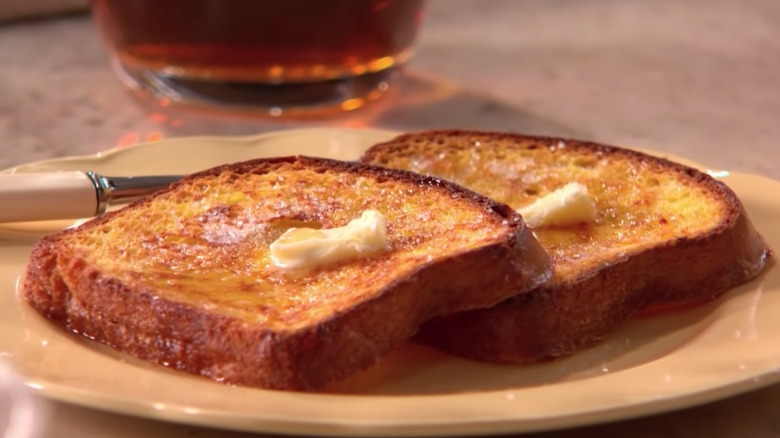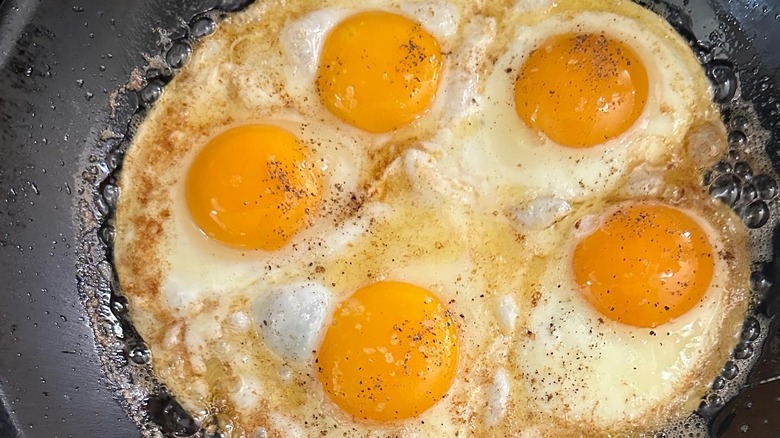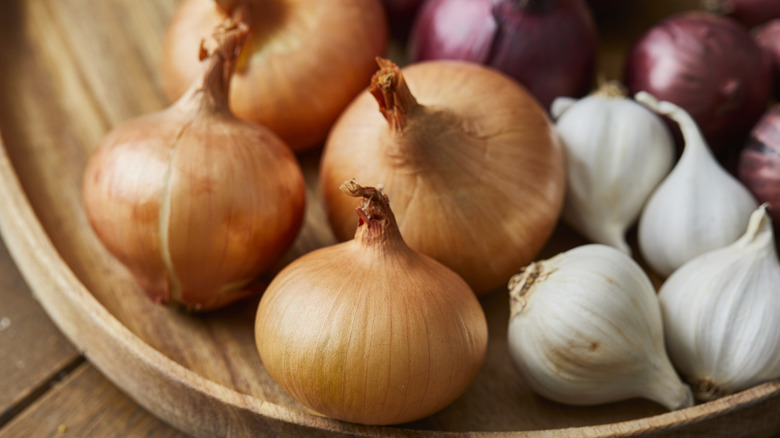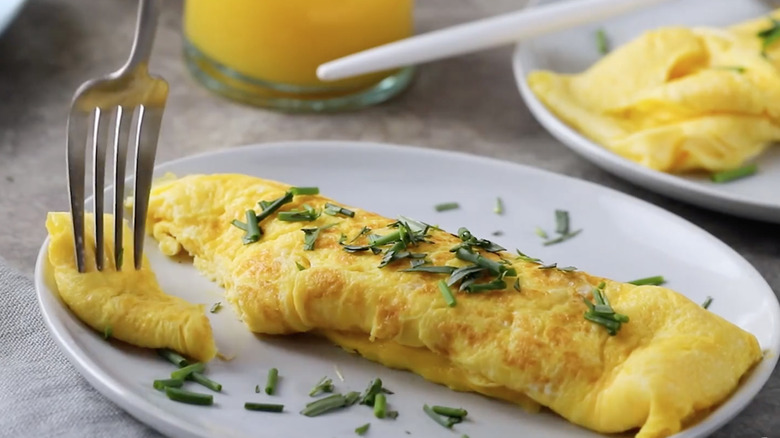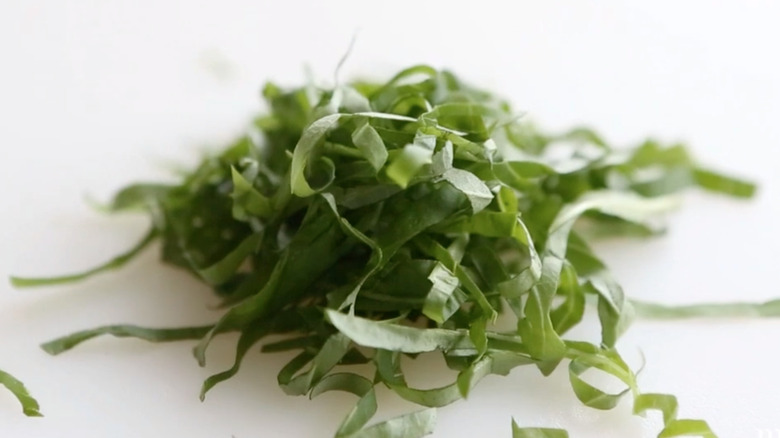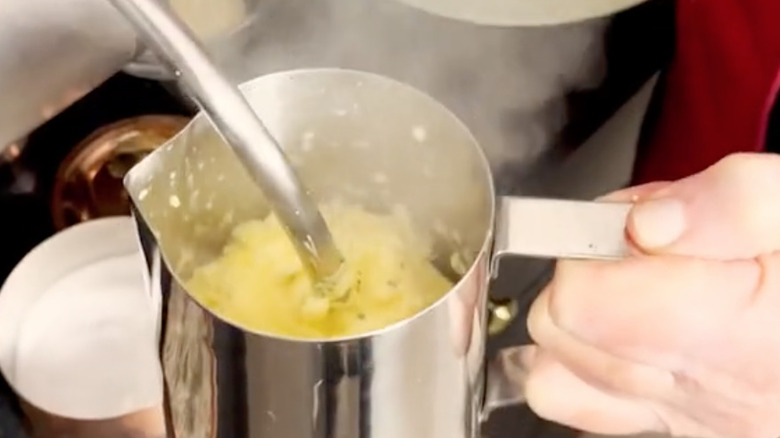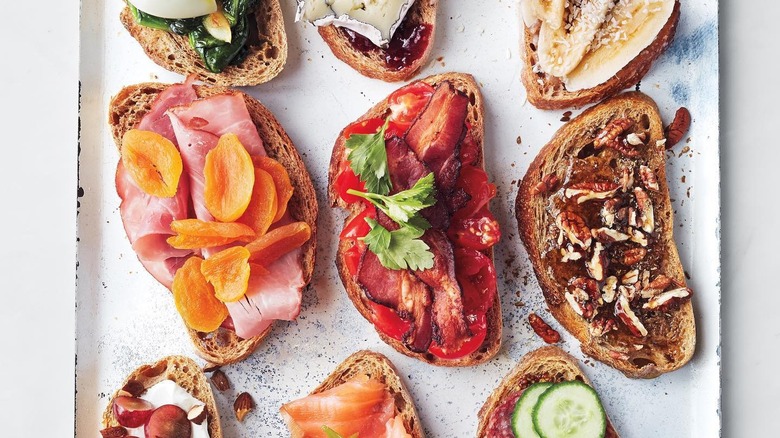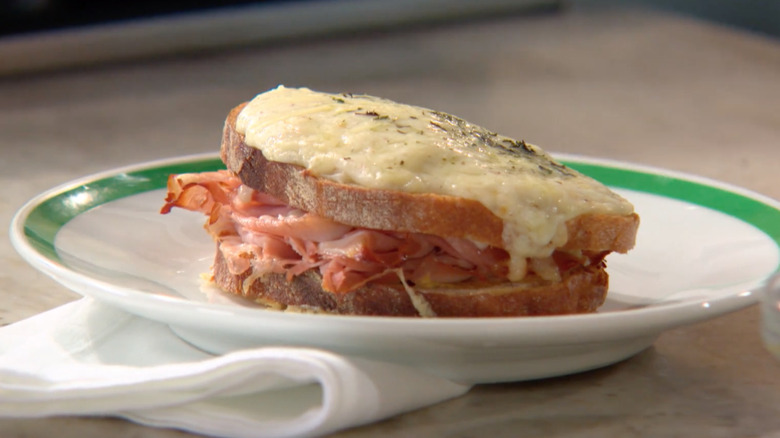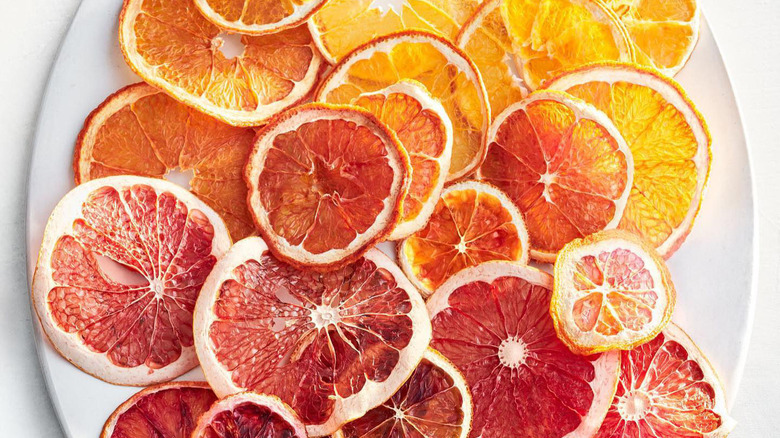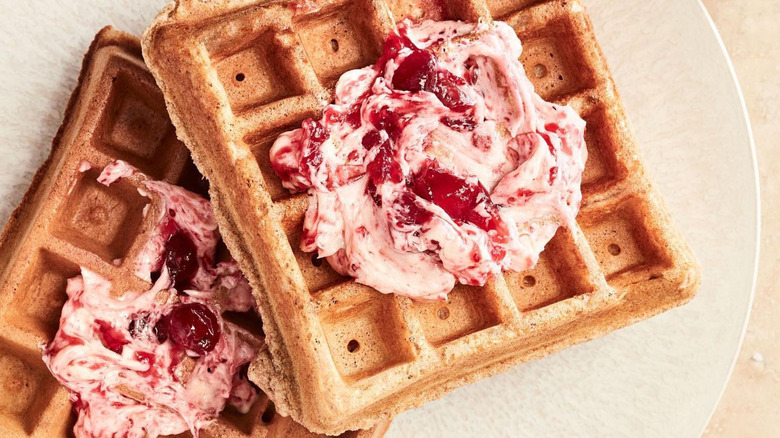Martha Stewart's Best Tips For Elevating Your Breakfast
You might think you'll have to set your alarm for crack-of-dawn-o'clock in order to put together a Martha Stewart-inspired fried egg. But we sourced breakfast tips from the iconic homemaker that are simpler than you'd imagine — and totally worth it.
First, collect fresh eggs from your backyard coop without disturbing your Araucana chickens, just like Martha. Kidding! We're not assuming her identity, we're just cooking breakfast like her. Hope you're ready for a spread, because these are recipes you're going to want to experience for yourself.
From her famous "cappuccino eggs," to Dutch babies, French toast, croque monsieurs, and even the best hard-boiled eggs, these tips add major flavor, soothe your groggy tummy, and even keep you from crying (we know this sounds strange, but read on to find out more). Oh, and there are fluffy waffles. And lots of butter. Hungry yet? Rise and shine, these are Martha's best tips to elevate your breakfast.
She adds Grand Marnier to French toast
Martha added Grand Marnier to basic French toast and pretty much blew up the internet. For the recipe she calls Martha's French Toast, she squeezed fresh orange juice into the egg mixture, then grated orange zest, and topped it off with Grand Marnier. Social media exploded and everyone died (like the coffin/skull emoji kind, not the literal kind).
We pegged this as a front-runner since we've made her spiked apple cider in the past, which was beyond booze-ilicious. But Martha goes easy on this one by using just 2 ½ tablespoons of orange liqueur. Citrus helps break up rich, syrupy flavors with a brightness that also adds a bit of je ne sais quoi. Martha starts with ingredients that would be delicious on their own: Brioche bread, six farm-fresh eggs, and Ronnybrook Farm milk that comes in a quaint glass bottle. Plus, she doesn't hold back on the toasting part.
Martha adds both butter and oil to her skillet, and fries each slice until it's golden and crispy. She then lets the slices rest on a drying rack, so they're primed for trimmings. She explains, "French toast like this should never be greasy, should never be oily. Top it with a little pat of butter and some glistening sanding sugar or maple syrup." Yes, you drain off the extra buttery oil so you can put more butter on it again. Bless.
She uses room-temp eggs for hard boiling
This tip is all about the fine art of executing a flawless hard-boiled egg. And Martha's method starts with perfect, room-temperature eggs — in ombré, eggy, pastel colors and a slightly glowing shell, per usual.
Martha's chicken-to-table eggs can stay out on the counter for up to several weeks since they haven't been washed and therefore still have their protective "bloom" layer, which keeps them bacteria-free. But if you pick up your eggs from the store, they have to stay in the fridge. Still, Martha has a trick for that. "Take them out about an hour before you cook them," she says of refrigerated eggs. Doing this prevents eggs from freaking out once they hit hot water (see: Cracking of the shells, and egg whites sticking to the shell and ruining a good peel).
She adds her room-temperature eggs to a saucepan with cold water, brings it to a boil, pops the lid on, and then turns the heat off immediately. "Eggs should never actually be boiled for any length of time," she explains, "Or they will turn rubbery and dry." Time those suckers to sit in the hot water for 13 minutes, then plunk them immediately in an ice bath to stop the cooking. Martha then cracks open the wide end of the egg and uses the little "air sac" inside the bottom of the egg to start peeling. The yolk should be done, but just a little soft and creamy.
She goes savory with breakfast soup
Not every day has to start out with a yogurt parfait, or even anything typically considered to be American breakfast food. Martha mixes it up by cooking an entire slew of satisfying breakfast soups. (No, Cookie Crisp isn't a soup.) This type of first meal has always been a popular pick around the world, and with Martha's recipes, you can easily make it your favorite meal of the day.
Just like you might do a little yoga in the morning to warm up your body, eating a warm breakfast preps your digestion for the rest of the day by gently firing up your metabolism. It's also a traditional Ayurvedic practice — and with Smoky Sweet Potato soup, Mushroom-and-Dill Chicken and Dumplings, or Ginger-Lemongrass Broth with Noodles and Broccoli on the menu, we'd happily slurp soup at 6 a.m. Even better, you can make it ahead of time like you're your own private chef.
For her Chicken-and-Mushroom Congee, Martha celebrates the beloved Asian rice porridge with chicken thighs, shiitake mushrooms, sesame oil, and chili sauce. (We also wouldn't say no to chili crisp.) Chopped scallions help craft a colorful masterpiece.
She squeezes lemon on her Dutch babies
Some people do Nutella, some do peanut butter. Others do apples or fresh fruit with cream and maple syrup. But if you wanna go classic with a twist, Martha tops her Dutch babies with a spritz of fresh lemon.
A traditional Dutch baby will typically be served with lemon curd or jam. But Martha keeps her Crispy Cast Iron Pancake version light as air by using just the juice of a lemon, squeezing it over the pancake while the dough is still puffy from the oven. The acidity of the citrus is meant, once again, to shine through the baked-in sweetness of the dish. A generous flurry of powdered sugar turns this breakfast treat into a full-fledged dessert. "If you want, serve it with some bacon," Martha advises. Done.
She also incorporates deliciously spicy nutmeg into the ingredients for Martha's Dutch Baby recipe. It's a riff on a dish by New York Times editor and writer, David Eyre, who first published a crazy-looking pancake recipe in 1966 that was baked in the oven and topped with a fresh squeeze of lemon — just like Martha's.
She skips the skillet and bakes her French toast
Speaking of things that usually have us sweating over the stove, Martha gives her skillet the morning off, and cooks her Heavenly Oven-Baked French Toast in the — you already guessed it — oven. It's not a casserole, it's individual French toast slices. And it's a straight-up magic trick if you're cooking for a crowd.
Dishing up 12 slices at a time, Martha starts with French brioche, dipped in her egg mixture, and then divided between two baking sheets, which are each lined with a silicone pad. Skip the parchment paper because the broiler at the end of the bake will torch it. Cook for 10 minutes at 375°F, then crank up the broiler for a final two to three minutes at 480°F, for a toasty, golden brown crust. Then serve it hot. Martha says, "Since we haven't fried this, and there's no grease and no calories from butter, you can even add a little tiny bit of butter on top." We're feeling that butter math, plus the granulated sugar and real maple syrup she also drizzles over the dish.
Pass the hard work onto your oven, so you can cook for a party. Or just save yourself those extra butter calories from the pan. Either way, you'll end up with the toastiest French toast this side of the Atlantic.
She melts butter (not oil) for fried eggs
So glad we finally made it to a breakfast tip that doesn't involve butter — wait! There's butter again. Martha turns her nose at even the most luxurious of oils, in favor of frying her eggs in sweet, delicious butter. But we promise there's an actual reason for it, other than it's just freakin' awesome.
"Use butter rather than oil to minimize the sticking," Martha explains. "Butter carries anti-sticking emulsifiers in it...and the butter will add that additional flavor that people really like." It all goes back to the proteins in butter, which are cream remnants that tag along in tiny water particles. Those guys make it so your fried egg easily glides off the skillet, as sunny as you'd like.
Martha likes her fried egg with a perfectly domed yolk, so she sets the yolk by briefly covering her skillet with a lid to help it keep its shape. Of course, your buttery fried egg will go perfectly with Martha's toast and country bacon.
She chops onions near an open flame to tame the tears
If you're already tearing up just thinking about onions, Martha's got what you need: A small fire. Chopping onions next to an open flame keeps your eyes from going full Niagara Falls — which is helpful when you're, say, wielding a knife. (We're onion-chopping criers, too, so we feel your pain.)
Parked next to a blazing flame on one burner of her gas oven, Martha effortlessly chopped away at her share of onions, telling fans, "Slice onions as close to an open flame as you possibly can arrange." This should be a safe, workable distance since no one wants to trade crying for third-degree burns. Back when she was just starting out in the biz, this was Martha's go-to hack for getting through piles of onion prep. "You can chop 20 to 30 pounds of onions as I used to do when I was catering, without shedding even a tear."
So why does this trick work? The flame supposedly burns the irritating onion gasses out of the air, so your eyes don't have to suffer through being exposed to the stinging sulfur. (Psst. You can take the onion goggles off now.)
She cooks her omelets with clarified butter
Surprise, it's butter again — but with a twist. Martha cooks up her omelets with clarified butter which creates eggs that don't stick to the pan and are then fluffier, tastier, and all-around good-er.
"Clarified butter is unsalted butter that has been melted and separated from any of the whey or milk solids that are found in butter," Martha noted as she whisked her extremely fresh eggs. In the absence of those solids, clarified butter earns a higher smoke point, and won't brown when cooked at high heat. It makes for a wonderfully slippery surface on which to cook omelets, since they require some moving around the pan. Martha rolls her omelet French-style (It's an American thing to fold it like a taco), and serves it on a warm plate with fresh herbs.
To make your own clarified butter, also known as ghee, melt a cup of butter in a pan, without stirring. Take it off the heat, let it rest for five minutes, then gently scrape the foam off the top. Next, pour the butterfat into another container, without disturbing the milk solids that should now be settled at the bottom of the pan. Boom. "Liquid gold." Now back to practicing rolling our omelets the French way.
She chiffonades her fresh basil
Basil, whether chopped, minced, or dried, is rarely a bad idea, but sometimes it can feel a bit basic. Luckily, Martha gives this sweet-n-spicy herb the upgrade it deserves by slicing it up a la chiffonade. It's a French technique, and as Martha said it herself, "It's a good thing."
The method for this might seem like something Snoop Dogg would have taught her, but it starts with gathering a few basil leaves, and then rolling them into a ... let's just call it a roll. "Very gently roll up the pile, and with a sharp, sharp knife, cut — on an angle — very thin slices through that roll," Martha instructs. The basil then unfolds like paper snowflakes.
The cut results in longer strips of basil, more like herbaceous threads. You can also chop up just about any flat-leafed herb or lettuce this way. Top a pizza, jazz up that omelet, or liven up a salad. The world is your chiffonade oyster.
She scrambles eggs in a cappuccino machine
Chef hat pleats used to represent the number of ways each chef could cook an egg. And if Martha Stewart wore a chef's hat, it would have one billion pleats. Adding another fold to the brim, she serves what might be the most exciting way to scramble an egg: Her viral sensation, Cappuccino Eggs.
Right up front, we're not sure how she cleans eggs out of the milk frother. But this trick sure is fun to do with someone else's cappuccino machine! "If you have a steam wand, you can cook your eggs in a matter of moments," Martha shared, as she prepared her cappuccino machine at home. First, she cracks two eggs into the steamer pitcher, then she adds pinches of salt and pepper, plus roughly a teaspoon of butter. Then, the milk frother gets to work steaming the eggs, filling them with air, and spraying little bits of eggs here and there. In literal seconds, they're done. "It's like souffléed eggs," she says.
Martha debuted her frothed-up eggs on "Chopped" in 2020, but instant internet buzz only uncovered the fact that she's been doing this for years. She was first inspired by her friend, Chef Jody Williams from NYC's Buvette restaurant. So, like, everyone's making eggs with cappuccino machines now?
She sets up a bruschetta buffet
We've been limiting ourselves with toast for far too long. Did you know you could put things on bread that aren't avocado? Martha brings impressive variety to her toast with her genius idea for a "breakfast bruschetta bar."
It's an especially brilliant tip if you've got a hungry crowd wondering what's on the menu. Plus, from sweet to savory, you can go for as many options as you like. Martha offers 61 different topping combos — no pressure. For sweet breakfast fans, she suggests coconut oil, banana, and coconut flakes, or raspberry jam with a slice of aged goat cheese. Savory guests might enjoy roasted red peppers and bacon, or sautéed spinach and a soft-boiled egg. Salmon and chives, or salami and cucumber, all you need to do is load up your slice and pop it in the toaster oven.
Martha does offer a few guidelines on how to craft a seamless spread. She likes a rustic sourdough or seed bread for the base. She also explains that all of your toppings should be ready to rock; cheese should be sliced or crumbled, fruit should be peeled and sliced, and any cooked toppings should be cooked ahead of time. Skip the messy, drippy, or saucy toppings that don't stay in place, and you'll be the toast of the town at your next brunch.
She keeps the ingredients French for her Croque Monsieur
We know Martha wouldn't make a classic French sandwich without using the best ingredients. (Yes. Farm fresh eggs, we get it.) But she takes things a step further for her Buvette's Croque Monsieur by using the best French ingredients. It's a trick that makes this dish taste like it was just flown by private jet from the City of Light and into your kitchen.
Martha's croque features a ham and cheese sandwich topped with a bechamel sauce and a sprinkle of herbs de Provence. Along with freshly grated nutmeg for her bechamel, she whisks in a really good Gruyère cheese. For the sandwiches, she slices a fat baguette and smothers it with French mustard. "You want an authentic bistro menu? Use a nice plain, Dijon mustard," she says. She adds prosciutto cotto, jambon royale hams, and Gruyère, and closes the sandwich before spreading the bechamel on top (plus more cheese). "For these croque monsieurs you want real authenticity."
Each sandwich then gets a light dusting of herbs de Provence, an iconic dried blend from the south of France. Just a little goes a long way, adding fragrant notes of basil, fennel seed, marjoram, lavender, rosemary, sage, thyme, and summer savory. It's basically the everything bagel seasoning of Marseille. You then dangle your feet from the Eiffel Tower in your mind, and bite into the most amazing ham and cheese you've ever tasted.
She skips the OJ and bakes citrus crisps
Starting now, we're living for the "Citrus Chips Aesthetic" and there's no better way to celebrate this trend we just invented than with Martha's Citrus Chips recipe. They come out like tiny stained glass masterpieces, and she says they "taste like sunshine."
They're also very simple to make. Just gather your four favorite citrus (Martha suggests navel, Cara Cara, or blood oranges), and slice them into rounds that are about 1/8th-inch in thickness. Then, turn your oven into a low and slow food dehydrator. After placing the slices on wire cooling racks over two baking sheets, bake your crisps at 175°F for four to six hours, rotating every two hours. Let them cool, and crisp up, and they're ready for their breakfast debut.
Maybe we're playing it fast and loose, but we could see trying this with grapefruit or limes. Maybe pink lemons, or yuzu. And we would eat Meyer lemons all day. Martha suggests sprinkling some cinnamon over cottage cheese as a dip for your crisps, but we would also consider marshmallow fluff as a real contender (especially if those grapefruit wheels don't quite work out).
She spreads cranberry butter on her waffles instead of syrup
Martha's whole vibe has always been classic and timeless. But while she may almost always drizzle Vermont maple syrup (or New York state, New Hampshire, or Maine maple syrup, as she recommends) on her waffles, once in a while, she mixes it up and packs those sweet, puffy squares with smooth, creamy cranberry butter.
This might be a trick to use up your leftover Thanksgiving cranberry sauce, but TBH, we'd make a new batch of cranberry sauce just for this, any time of year. Martha blends unsalted butter with an equal amount of cranberry sauce, and then serves it on warm pancakes, biscuits, or waffles. No syrup needed.
But about those waffles though — they're actually made of buttery puff pastry. You know we couldn't wrap this up without talking about butter! Martha even created a Puff-Pastry Waffle Hearts recipe that she calls "Puffles," which incorporate Dufour frozen pastry dough, which is waffled and then filled with Nutella. We officially can't take it anymore and we're making breakfast for dinner and all the other meals, too. #MarthaStewartBreakfastForever.


